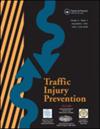桥梁相关和非桥梁相关碰撞事故的比较:严重程度、涉及车辆和驾驶员特征。
IF 1.6
3区 工程技术
Q3 PUBLIC, ENVIRONMENTAL & OCCUPATIONAL HEALTH
引用次数: 0
摘要
目标:按长度计算,桥梁只占交通网络的一小部分,但仍然很容易发生交通事故。尽管全球范围内对桥梁相关碰撞事故进行了广泛研究,但很少有研究探讨桥梁相关碰撞事故与非桥梁相关碰撞事故之间的差异。因此,本文试图通过对澳大利亚维多利亚州的案例研究,比较与桥梁相关的碰撞事故和与桥梁无关的碰撞事故,以补充现有知识:方法:利用维多利亚州 2006 年 1 月至 2023 年 4 月期间的撞车数据,通过卡方检验来研究撞车类型之间的差异。然后采用部分比例赔率模型来确定与桥梁相关的撞车事故是否更严重:总体而言,分析表明,与非桥梁撞车相比,与桥梁相关的撞车往往会导致更严重的伤害结果。此外,有证据表明,与非桥梁撞车事故相比,与桥梁相关的撞车事故更有可能是单车撞车事故,更有可能涉及重型车辆以及年轻/男性驾驶者,更有可能发生在高速路、区域性地区和夜间:结论:由于与桥梁相关的交通事故的严重程度较高,因此建议实施一项旨在加强桥梁交通安全的针对性计划。考虑到道路网络中桥梁的存在,特别是在许多条件较差的地区,有必要考虑改装以及低成本解决方案,以配合驾驶员教育和宣传计划。这些计划应针对与桥梁相关的碰撞事故风险较高的特定群体,如年轻男性驾驶者。本文章由计算机程序翻译,如有差异,请以英文原文为准。
A comparison between bridge-related and non-bridge crashes: severity, vehicle involvement, and motorists’ characteristics
Objectives
Bridges, though representing a small portion of transport networks by length, are still prone to traffic crashes. Despite extensive research on bridge-related crashes globally, there’s a scarcity of studies exploring differences between bridge- and non-bridge-related crashes. Thus, this paper attempts to add to the current knowledge by comparing bridge-related crashes and non-bridge crashes using a case study in Victoria, Australia.
Methods
By utilizing crash data in Victoria between January 2006 and April 2023; the Chi-squared test is conducted to examine differences between crash types. Partial proportion odds models are then employed to establish if bridge-related crashes tend to be more severe.
Results
In general, the analysis reveals that bridge-related crashes tend to result in more severe injury outcomes compared to non-bridge crashes. Furthermore, there is evidence that bridge-related crashes are more likely to be single-vehicle, to involve a heavy vehicle as well as young/male motorists, and to occur on high-speed roads, regional areas and at nighttime than non-bridge crashes.
Conclusions
A targeted program aiming at enhancing traffic safety at bridges is recommended due to the higher severity of bridge-related crashes. Considering the presence of bridges on the road network, and particularly in regional areas where many are in poorer conditions, it is essential to consider retrofitting as well as low-cost solutions in order to complement motorist education and awareness programs. Specific groups with higher risks of being involved in bridge-related crashes, such as young male motorists, should be targeted in these programs.
求助全文
通过发布文献求助,成功后即可免费获取论文全文。
去求助
来源期刊

Traffic Injury Prevention
PUBLIC, ENVIRONMENTAL & OCCUPATIONAL HEALTH-
CiteScore
3.60
自引率
10.00%
发文量
137
审稿时长
3 months
期刊介绍:
The purpose of Traffic Injury Prevention is to bridge the disciplines of medicine, engineering, public health and traffic safety in order to foster the science of traffic injury prevention. The archival journal focuses on research, interventions and evaluations within the areas of traffic safety, crash causation, injury prevention and treatment.
General topics within the journal''s scope are driver behavior, road infrastructure, emerging crash avoidance technologies, crash and injury epidemiology, alcohol and drugs, impact injury biomechanics, vehicle crashworthiness, occupant restraints, pedestrian safety, evaluation of interventions, economic consequences and emergency and clinical care with specific application to traffic injury prevention. The journal includes full length papers, review articles, case studies, brief technical notes and commentaries.
 求助内容:
求助内容: 应助结果提醒方式:
应助结果提醒方式:


